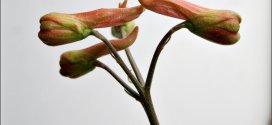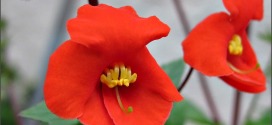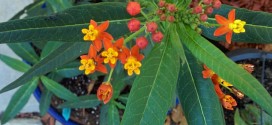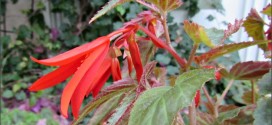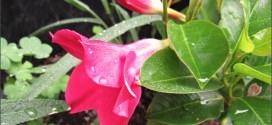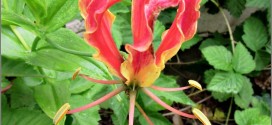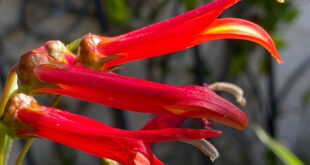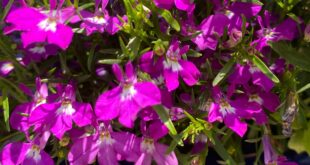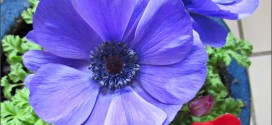Spectacular in its vivid red grandeur, this tuberous rooted Delphinium is a boon to Summer dry gardens. To 3-4’ tall, it’s been known to reach a majestic 6’ when happy. Hummers and bumblebees go nuts for 1.5” intense red, long-spurred “elf hat” flowers during Spring and early Summer. Native to our coast and foothills from Monterey South, this heat lover …
Read More »Tag Archives: red
Alonsoa meridionalis
Mask Flower (Alonsoa meridionalis) Blooms lasting three months or more. When it slows down, just cut back to 6” tall, add a bit of compost & boom – it’s back with another explosion of 1” cinnabar-red, roundish Snapdragon-like flowers. Even in Winter! Nice in front of a bed & an excellent container plant. A bushy 30” high & 18” wide.
Read More »Blood Flower – Aclepias curassavica
Blood flowers (Aclepias curassavica) are red-orange with yellow hoods. Flowering continues throughout the summer to early autumn. Hummingbirds, butterflies and bees are attracted to the flowers. Monarch butterflies lay eggs on this plant and the resulting larvae (caterpillars) use the plant leaves as a food source. Flowers are followed by long, narrow seed pods (3-4” long) which split open when …
Read More »Begonia boliviens s. ‘Santa Cruz Sunset’
The Santa Cruz Sunset begonia has dramatic angled petals. These plants fall into the tropical and subtropical category of perennials, growing well in U.S. Department of Agriculture plant hardiness zones 6 through 11. Many varieties with ornamental leaves and blossoms grow well outside in USDA zones 10 and 11, while hardy begonias survive winters in USDA zones 6 through 9 …
Read More »Mandevilla vine
Among the garden’s most elegant vines, mandevilla offers stunning trumpet-shape flowers in shades of pink, white, or red. It’s the perfect plant for creating a lush, tropical look. Mandevilla is usually grown as an annual, though it can be overwintered indoors in a bright spot. Note: All parts of this plant are poisonous. First planted in 2014. I relocated the …
Read More »Gloriosa Lily
The exotic yellow and red blossoms of the gloriosa lily (Gloriosa superba), also known as the glory lily, flame lily and climbing lily, cover the plant’s 3- to 8-foot-tall vine. Native to Africa and Asia, gloriosa lilies are generally available in two colors: the red “Rothschildiana” and yellow “Lutea.” A tender perennial, this tropical vine thrives in the warm summer …
Read More »Lobelia aguana
Hundreds of well displayed, exotic, bearded, 2″ flowers jut out on prominent stems up and down the numerous upright stalks almost year round with the heaviest bloom occurring in Summer and Fall, with plenty of blooms continuing thru Winter. Pretty, evergreen, linear foliage. Can be cut back to 2′ tall in Winter to contain growth. Hummingbird heaven! Lobelia aguana, a …
Read More »Lobelia erinus “Fountain Rose”
Lobelia erinus “Fountain Blue”xThis variety of Lobelia has masses of graceful, tumbling pink half-inch flowers. It softens the edge of the garden container as well as hanging baskets and window boxes. Blooms forever it seems and often lives over here in USDA Zone 8b, and always self-sows to grace your gardening world every year. Use rich soil for prettiest show! …
Read More »Hibiscus
Hibiscus adds a tropical flair to your Sunnyvale garden. It is a bushy, evergreen shrub or small tree growing 8 to 16 ft tall and 5 to 10 ft wide, with glossy leaves and solitary, brilliant red flowers in summer and autumn. The 5-petaled flowers are 4 inch in diameter, with prominent orange-tipped red anthers. Provide the plants with at …
Read More »Anemone
Anemones, also known as windflowers, are a diverse group, with various species blooming in spring and fall. Some have fibrous roots and are found in the perennials section of nurseries and garden centers. Others grow from tubers that are sold and planted in the fall along with spring-flowering bulbs like tulips. About This Plant Spring blooming anemones are low growing …
Read More »